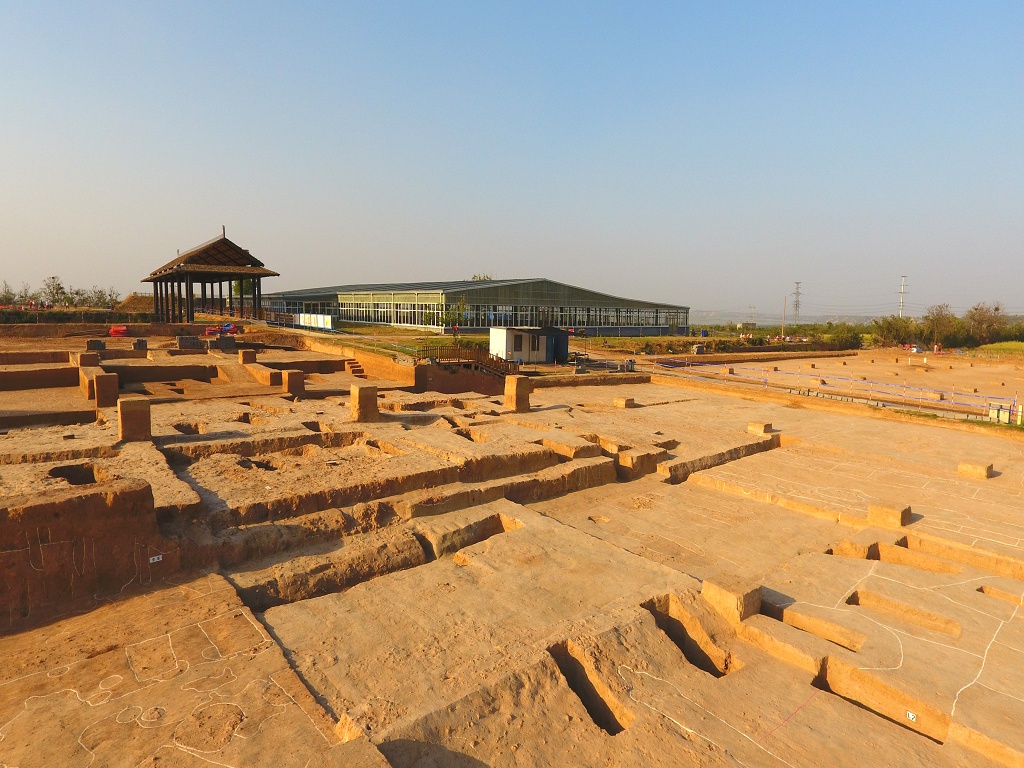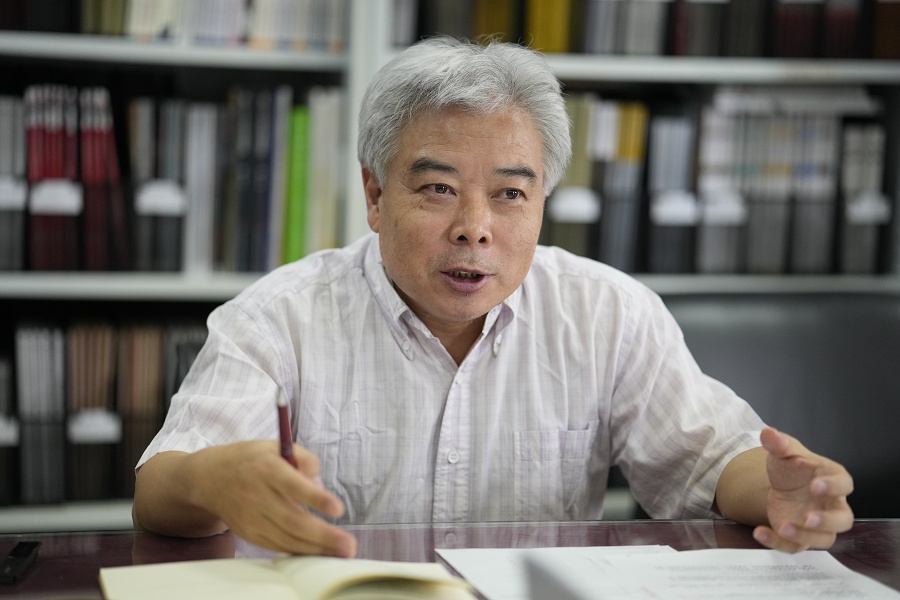Partnering on a Past-Inspired Future

Cao Bingwu, former chief engineer of the Chinese Academy of Cultural Heritage, never provided ambiguous answers to unfamiliar questions with his research notes. However, he dropped his usual professional and rigorous posture and burst into laughter in reaction to the common perception that archaeology is a poetic science with a “great perhaps.”
“Dedication to archaeology is surely hard,” he said. “Most of our days were spent sweating like farmers under a scorching sun.” Since his earliest days of archaeological excavation, Cao has sought to relay “whispers” from thousands of years ago to everyone.
Cao’s study and work in the 1980s and 1990s enabled him to witness how Chinese archaeology evolved alongside the introduction of new archaeology from abroad, honing of underwater archaeology, and experimentation with multidisciplinary and comprehensive excavation research at the Bancun site in Henan Province. Since 1997, Cao had worked for the National Cultural Heritage Administration and the newspaper China Cultural Relics News successively. “I left the archaeological frontlines quite long ago,” he admitted humbly. “Nowadays, I mainly contribute as a ‘cheerleader’ providing supportive analysis.”

Cao Bingwu, former chief engineer of the Chinese Academy of Cultural Heritage, emphasizes the pattern of “diversity in unity” of Chinese civilization. (Photo by Wan Quan/China Pictorial)
“Oscars of Chinese Archaeology”
Whether a standing bronze figure resembling Ultraman or a dazzling complete gold mask, each new discovery at the Sanxingdui Ruins site in Sichuan Province amazed the public. On March 31 of this year, the sacrificial area of the site was ranked among China’s top 10 archaeological discoveries of 2021.
Dubbed the “Oscars of Chinese archaeology,” the annual awards have been organized by China Cultural Relics News since 1990, adhering to such benchmarks as academic significance, evacuation standards, and more. As an employee of the newspaper starting from 2000, Cao was able to witness how the flagship annual event evolved from “a tea party in the field” to a major feast kindling wide public archaeology fever.
“In the first 10 years of the awards, you could tell they really started from scratch,” Cao recalled. “Back then, the newspaper invited a handful of famous archaeologists from Peking University, the Institute of Archaeology at the Chinese Academy of Social Sciences, and the National Cultural Heritage Administration to sit around and select 10 items from those covered in the press over the past year. Then the newspaper would organize some follow-up coverage.” Peng Qingyun, then editor-in-chief of China Cultural Relics News, shared the origins of the event with Cao.
Since 2000, the newspaper has organized the event in partnership with the Chinese Society of Archaeology to enhance its authority. They started inviting archaeological project leaders to author articles and experts to comment, publishing compilations of the archaeological achievements over the previous decade, and holding press conferences at the Great Hall of the People in Beijing. And the selection method also quietly changed. “Archaeological team leaders are invited to Beijing to showcase their findings to judges, the media, and other spectators like a ‘thesis defense.’ Once results are determined, a press conference is held to welcome media coverage.” Additionally, follow-up seminars are scheduled to discuss how archaeological discoveries can boost public interest in the protection of urban heritage and enhance urban development as well as on the progress of archaeological disciplines and other topics.
When the event’s 30th anniversary collided with the outbreak of COVID-19 in 2020, the final round of appraisals was livestreamed online, as per a decision from the National Cultural Heritage Administration. The event attracted more than 100 million views on the first livestreaming day. In 2022, the competition became even fiercer and drew wider attention because all the candidates were discovered in 2021, to mark the centenary of the founding of modern Chinese archaeology. Data shows posts concerning the “Top 10 Archaeological Discoveries” received 480 million views on Chinese online platforms Weibo and Toutiao. The total viewership of relevant series, coverage, and live broadcasts exceeded 700 million.

A pottery pot excavated from the Shuanghuaishu site in Gongyi, Henan Province. (Photo courtesy of Cao Bingwu)
“Multi-Petaled Flower”
Honoring the “Top 10 Archaeological Discoveries” over the past decade helps illuminate how Chinese archaeology developed with gradually clear frameworks of time and space and increasingly rich historical and cultural significance. “In recent years, the selected top 10 archaeological discoveries have been quite diverse in time, space, and type,” Cao said. “It’s also noteworthy that they contribute to demystifying some academic issues such as the pattern of ‘diversity in unity’ of Chinese civilization.”
For example, the Shuanghuaishu site in Gongyi, Henan Province, one of China’s “Top 10 Archaeological Discoveries” of 2020, was the capital city of the ancient Heluo Kingdom dating back around 5,300 years, so it was crowned “the embryo of early Chinese civilization.” As a huge residential complex of the mid-late period of the Yangshao Culture, it has broken many archaeological records domestically: a confirmed site area of 1.17 million square meters surrounded by three huge ring trenches each with external access, forming a strict defense system and a wall with the earliest barbican structure.
“A metaphor circulating in Chinese archaeology circles imagines Chinese culture in the Neolithic Period as a huge multi-petaled flower,” Cao explained. “The Central Plains region in the middle and lower reaches of the Yellow River is the heart of the flower, and the Yangshao Culture plays a dominant role. Recently, some ‘Top 10 Archaeological Discoveries’ have helped us rediscover the Central Plains, bringing the ‘flower heart’ back into the spotlight.”
Archaeology, Cultural Relics, and Museums
The honor of ranking among the “Top 10 Archaeological Discoveries” can also drive archaeological sites to higher stages of protection and utilization. In the case of the Jiangkou ancient battlefield site in Pengshan District, Meishan City, Sichuan Province, a plan to build a museum at the original site was put on the agenda after it became a laureate in 2017. The museum is expected to open to the public after completion in December of this year.
Although the annual event has helped archaeological development to disseminate information, popularize knowledge, and improve public interest, according to Cao, public awareness about archaeology is still in its infancy with most just watching from the sidelines. Scientific management and long-term protection and utilization of archaeological resources still have a long way to go, with compilation and publication of archaeological reports and reasonable attribution and display of unearthed cultural relics needing improvement especially.
Displaying unearthed cultural relics in museums has become a new chapter for public archaeology, fueling the perception that museums are the ultimate destination of archaeological heritage. Consequently, Cao is constantly pondering how to smooth the necessary integration and stimulate inheritance and innovation of splendid traditional culture, which constitutes his trilogy of cultural exploration—Archaeology and Culture, Cultural Relics and Culture, and Museums and Culture.
“We can’t lock cultural heritage in a warehouse only to be subject to expert research,” he illustrated. “The entire nation needs to grasp knowledge on protecting and utilizing cultural heritage and tapping into the cultural creativity therein.”

April 12, 2016: Visitors enjoy the exhibition “Splendid Finds: The Archaeological Excavations at the Royal Cemetery of Haihunhou Kingdom in the Han Dynasty” at the Capital Museum in Beijing. Since the exhibition kicked off, tickets were hard to come by. The tomb of the Marquis of Haihun in Nanchang, Jiangxi Province, was ranked among China’s top 10 archaeological discoveries of 2015. (Photo by Guo Shasha/China Pictorial)
Mutual Exchange among Civilizations
“It’s a Golden Age for Chinese Archaeology—And the West is Ignoring It” read the title of an opinion piece authored by Rowan K. Flad, a professor in the Harvard Department of Anthropology, that ran in The Washington Post in May 2021, shortly after new discoveries at the Sanxingdui Ruins site were released. “American society has emerged from various geographical and cultural roots, and we should work harder to recognize and celebrate these diverse origins—including by paying more attention to the exciting discoveries in China,” wrote Flad, calling on Americans to pay more attention to Chinese archaeological discoveries.
Exploring the origins and development of the Chinese nation and its civilization has always been a major topic of concern for Chinese archaeology. Su Bingqi, a late Chinese archaeological theoretician, once summarized how Chinese archaeological discoveries over the recent century had contributed to new understanding of Chinese civilization. He described it as “cultural roots aged a million years, origins of civilization over 10,000 years old, an ancient country with 5,000-odd years of history, and a unified entity for 2,000 years.”
Furthermore, Chinese President Xi Jinping commended such achievements in a national research program dedicated to tracing the origins of Chinese civilization during a group study session on May 27. The program was launched in 2002, with about 400 scholars in 20 natural and social science disciplines from across the country taking part. Noting that Chinese civilization has been known for openness and inclusiveness since ancient times, Xi posited that it has gained new vitality through exchange and mutual learning with other civilizations.
On the coordinate axes of history, self-reflection can be made vertically while mutual exchange horizontally. Cao also labeled the current era as the best timing for mutual exchange among civilizations. “Civilizational exchange is a new issue within globalization, evidenced by the comparatively meager interaction between descendants of the two most enduring and prosperous civilizations,” Cao said. “Archaeology can clarify the ins and outs and characteristics of different civilizations to help draw future blueprints for building a community with a shared future for humanity.”